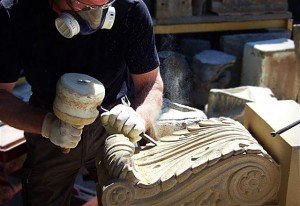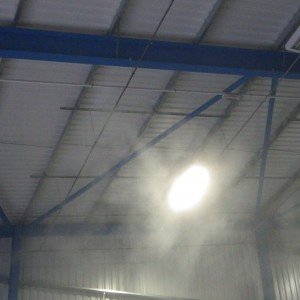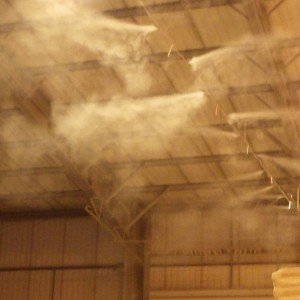Fiona Miles looks at the benefits of controlled fogging solutions such as Micronfog from Renby Limited, to supress dust in the workplace.
Serious dust health risks

Image courtesy of davidfrancestonemasonryltd.co.uk
Businesses which create dust as part of their operations are legally obliged to protect staff and must ensure that employees are protected from dust inhalation. This applies whether they are cutting, polishing or processing stone or cleaning and restoring stonework.
Stone dust contains Respirable Crystalline Silica (or RCS). If particles of this dust are inhaled, they can cause lung damage which can result in life-limiting and often life-threatening illnesses such as Silicosis and Chronic Obstructive Pulmonary Disease (or COPD).
We cannot underestimate the seriousness of this problem. The story below illustrates that businesses and their directors which do not adequately protect staff can face severe penalties.
Suspended prison sentence for director
In 2014 the director of a London stonemasonry business was fined £9000 in costs and was handed a 10 month prison sentence suspended for 2 years because he did not adequately protect his workforce from stone dust and ignored improvement notices given by HSE inspectors. His company only escaped a £50,000 fine for breaches of the legislation because it is no longer trading, and therefore does not have the means to pay.
The employees were placed at unnecessary risk of inhaling stone dust, (HSE inspectors reported) which can cause long-term health problems such as Silicosis and COPD. The company and director, were sentenced in July 2014 after an HSE investigation. Two improvement notices had previously been served requiring urgent changes, but in follow-up visits in June 2013 it was found that nothing had changed,
HSE Inspector Saif Deen said: “Stone dust can be incredibly harmful and exposure, even over a relatively short period, can have devastating consequences”. He explained that “Companies involved in processes that generate airborne dust [must have effective systems or equipment to protect their employees]”
Breathable dust is an occupational hazard, NOT “a fact of life”
Stone dust is commonplace at a stonemasonry due to polishing and grinding of stone. Some may say “If you work with stone, that’s just a fact of life, just one of the occupational hazards of the job”. A rather old fashioned idea maybe, but still prevalent today. In Victorian times, worker mortality and illness were commonplace; almost expected. Nowadays, however, we expect to be safe in our place of work and to be able to look forward to a reasonably healthy retirement. We don’t expect our job to cause our early demise.
Health and safety legislation and the HSE were introduced to counteract a frequent disregard for worker safety and provide statutory protection from occupational illnesses. The HSE’s remit to assess occupational hazards, set minimum standards and reduce people’s exposure to dangers, helps employers to protect staff and avoid becoming ill as a result of their chosen profession. It is why welders wear visors and construction workers wear hard hats.
Our high regard for safety in Western Europe is evidenced by the increase in use of legal action over the last 60 years against employers who place us at risk. Inhaling dust can cause asthma, COPD, silicosis or even lung cancer, so it is vital that adequate measures are used to limit exposure. The HSE sets strict exposure limits for many substances and RCS is no exception. In the UK, it is 0.1mg/m³, and it is likely to be reduced in years to come, in line with US and Canadian levels.
Fog is the instant solution to the problem of airborne dust
Robin Travis of Cheshire-based family business; Renby Limited understands the dangers of dust. After decades, of supplying the quarrying, mining industries with conveyors and conveyor covers designed to keep the dust down in those environments. His experience, and passion for the environment led Robin to develop an energy efficient solution to the problem, a fogging system, which he called MicronFog.
Many industries which face the problem of airborne dust turn to fogging, as it is the proven solution, offering reliable and effective dust control. Quarries, brickworks, alternative fuel power generators, ceramics manufacturers as well as root vegetable packers and processors, have solved their airborne dust problems with fog; reducing their exposure to legislative penalties and litigation.
Dust suppression with fog, when used with a dust collector system is the most economical and effective way to comply with the HSE work exposure limit for RCS of 0.1mg/ m³.
How does controlled fogging suppress dust?

Fogging can be cheaper and more effective for dust suppression than other methods.
So how does a fogging system control dust so effectively? Basically, fog supresses dust rather than extracting it. In a carefully designed fogging system, the droplets are so fine and therefore light that they become suspended in the air, mixing with airborne dust particles. The dust becomes attached to the water droplets and the combined weight is too heavy to remain airborne so they simply fall to the floor. The fog in such a system is so fine, it does not wet the floor or anything else in the area as it either evaporates or combines with the dust falling to the floor.
A simple (though admittedly rather basic) demonstration of the principle can be done at home with a sweeping brush and fine plant mister. (We note that unlike a genuine fogging system, the droplet size is larger and you may wet the floor a little).
Sweep a dry area where there is dust on the floor such as a dry shed or greenhouse. The dust is clearly visible in the air. Spray the plant mister as firmly as you possibly can through the dust clouds and watch the water droplets and dust drop to the ground. The resultant dust on the floor can be swept without more dust being kicked up, saving sneezes.
High pressure fogging systems, – purpose-built for dust suppression – such as MicronFog™ produce infinitely finer and more uniformly sized fog droplets than a basic plant mister. But, for the purposes of demonstration, the basic principle is the same. Fog is simply the most effective way to suppress dust, is very energy efficient and does not create a slip hazard by wetting the area.
“The fine fog generated by our fogging system has reduced airborne dust significantly”
Operations Director, UK Potato processor
Using fog to solve dust problems in the workshop
Good quality fogging systems help to control dust in several ways, whether it is used in a workshop, factory, warehouse, or other processing area:

Large area fogging:- Nozzles are attached to roof stays
Large area Fogging: Nozzles installed in roof areas allows fog to provide general dust suppression within in the fogged area of the building.
Work Stations: Nozzles positioned close to work stations can help to prevent dust becoming airborne. Much in the way that wet working stone can do, but without a wet floor.
Packing areas: These are occasionally forgotten. Some nozzles positioned in the packing area can prevent dust building up.
Vehicle and work movement: Dust caused by industrial vehicle movements is suppressed.
Fog successfully suppresses dust in Quarries, Stone loading areas, Biomass Power stations, Onion and potato packing and powder bagging facilities. It helps to keep dusty processes and workshops free of airborne dust. This means protected staff, a more pleasant working environment, less sickness time off, lower exposure to litigation and keeps the HSE inspector happy too.
If you have a DUST PROBLEM in your facility, make sure you consider fogging to solve the problem. You can find out more about Micronfog or visit Renby Limited.
What makes us susceptible to burnout?
In this episode of the Safety & Health Podcast, ‘Burnout, stress and being human’, Heather Beach is joined by Stacy Thomson to discuss burnout, perfectionism and how to deal with burnout as an individual, as management and as an organisation.
We provide an insight on how to tackle burnout and why mental health is such a taboo subject, particularly in the workplace.




